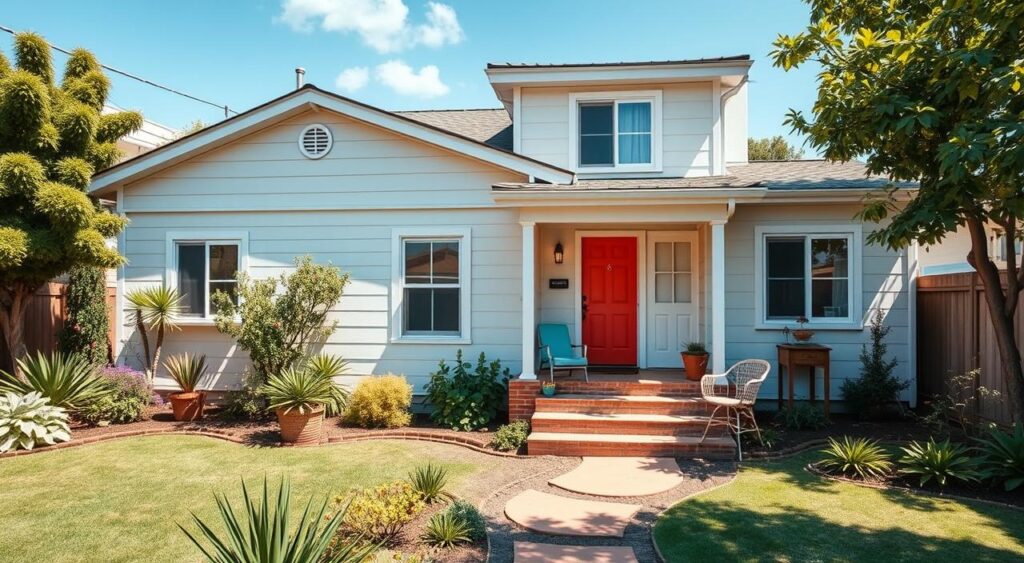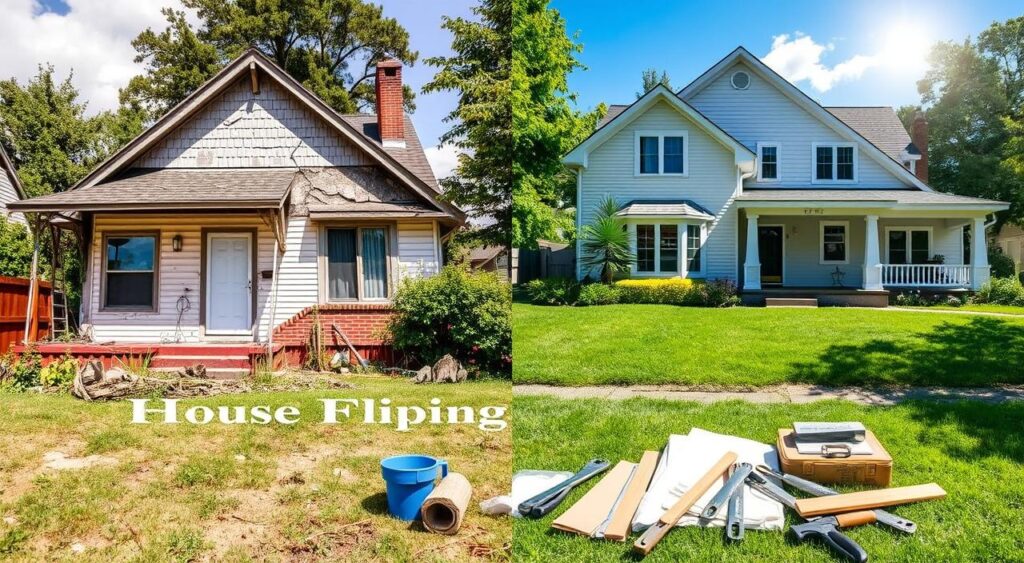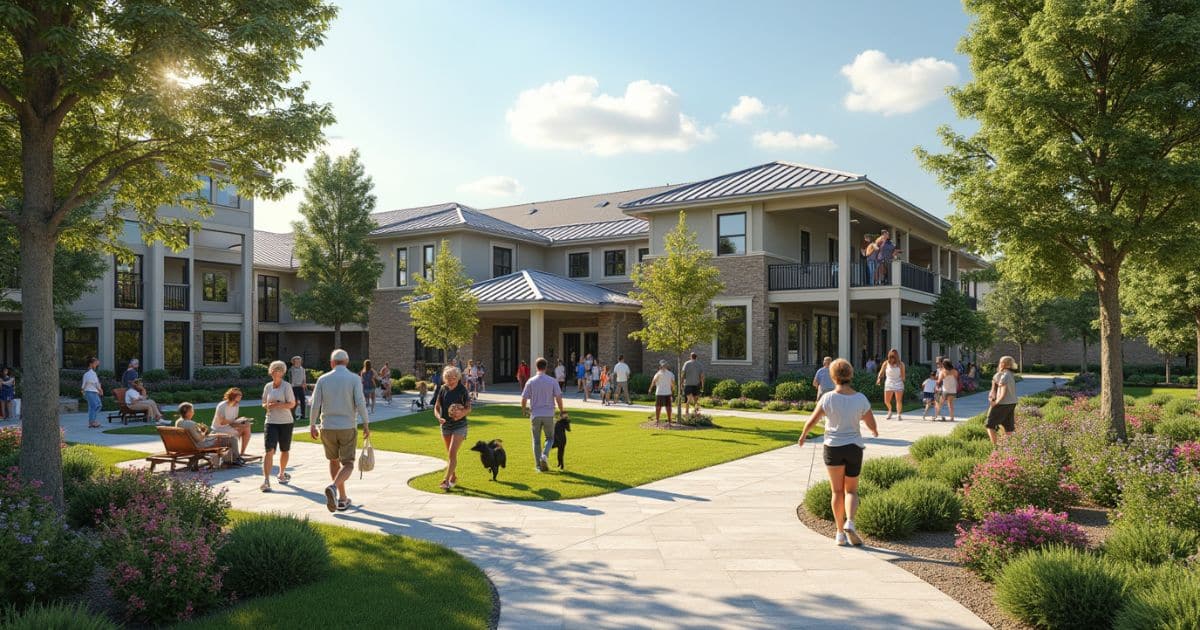Standing on my rental property’s balcony, I felt proud and accomplished. The sunset painted the sky in beautiful colors. This view was once just a dream, now it’s a real asset.
The world of real estate investment is vast and full of opportunities. You can invest in rental properties or fix and flip. But, how do you choose the right path?
Texas has seen its population grow by over 15% in the last decade. Housing prices have gone up steadily. Cities like Austin, Dallas, and Houston are hotspots for property investment.
In Texas, you can invest in multifamily properties, fix and flip, or commercial real estate. The state also offers tax benefits. These can increase your returns.
Success in real estate isn’t just about where you invest. It’s about your strategy. The buy-and-hold method or the BRRRR method (Buy, Rehab, Rent, Refinance, Repeat) each have their own benefits. For example, an investor could make $1,800 a month from a $300,000 property.
As we explore these strategies, remember to match your approach with your financial goals and risk level. Whether you like fix and flip projects or prefer the passive income of REITs, there’s a path for you.
Key Takeaways
- Real estate investment offers diverse opportunities for wealth building
- Texas real estate market shows strong growth and investment opportunity
- Various strategies cater to different investment goals and risk tolerances
- Tax benefits can significantly enhance real estate investment returns
- Success in real estate requires strategic planning and market understanding
- Both active and passive investment options are available in real estate
Understanding the Real Estate Investment Landscape

The real estate market is always changing. It’s influenced by economic shifts and new trends. To understand how real estate investment is changing in 2024, we need to know the current scene and what drives it.
Current Market Trends
After the pandemic, the best places to invest in real estate have changed a lot. With more people working from home, suburban areas are now more in demand. Also, buildings that are good for the environment are becoming more popular with investors.
Economic Factors Affecting Real Estate
Economic conditions are very important for real estate investments. Things like interest rates, inflation, and job numbers affect how much properties are worth and how much rent they can get. Knowing these factors is key to making good real estate investments.
Types of Real Estate Investments
The future of commercial real estate is changing, but there’s more to it than that. Investors have many choices:
- Residential properties for rental income
- Commercial real estate for business leases
- Industrial properties for manufacturing and logistics
- Land development for long-term appreciation
Each option has its own benefits and risks. They fit different investment plans and goals. As the real estate market keeps changing, it’s important to stay up to date on these choices to make wise investments.
Real Estate Investment Trusts (REITs): A Low-Maintenance Option

REITs make real estate investing easy. They let you invest in commercial real estate without the stress of managing properties. With over 225 REITs listed on major U.S. stock exchanges, you have many choices.
REITs are known for their high dividend yields. They must give 90% of their taxable income to shareholders. This rule often leads to dividend yields of 5% or more, attracting income-focused investors.
REITs give you a chance to invest in different types of commercial real estate. This includes:
- Office buildings
- Retail spaces
- Apartment complexes
- Healthcare facilities
- Industrial properties
You can start investing in REITs with just $500. This makes them a great choice for those looking to diversify their portfolios. The liquidity of publicly-traded REITs is similar to stocks, making it easy to buy and sell.
“REITs offer a low-cost entry point to real estate investing with the added benefit of professional management.”
While REITs have many benefits, they also come with risks. Their performance can be affected by interest rate changes. Also, individual REITs might not be diversified. It’s important to do your research and maybe talk to a financial advisor before investing in REITs.
Online Real Estate Investment Platforms: The Digital Approach
The digital age has changed real estate investing. Now, online platforms let investors find and invest in properties easily. These sites connect investors with developers, opening doors for both new and experienced investors.
Benefits of Crowdfunding in Real Estate
Real estate crowdfunding lets investors join forces to tackle big projects. It has many benefits:
- Lower investment minimums
- Diversification across multiple properties
- Access to commercial real estate projects
- Simplified real estate financing process
Top Platforms for Investors
Many platforms meet different investor needs:
- Fundrise: $10 minimum investment, suitable for non-accredited investors
- RealtyMogul: $5,000 minimum for REITs, higher minimums for other options
- Groundfloor: Offers short-term investments with a history of 10% annual returns
- CrowdStreet: For accredited investors, $25,000 minimum investment
Risks and Rewards
Online real estate investing has its perks, but it also comes with risks. Returns can vary from 2% to 20% a year. But, investments might be hard to sell. NerdWallet’s guide to real estate crowdfunding sheds light on the options and risks. Before investing, think about the platform fees, investment terms, and your financial goals.
Rental Properties: Building Long-Term Wealth

Rental properties are a great way to build wealth over time. They offer a steady income and the chance for property value to increase. The U.S. real estate market has seen steady growth, with home prices reaching $498,300 by 2023’s end.
- Steady income from rental payments
- Long-term property appreciation
- Tax benefits, including depreciation and capital gains tax advantages
- Leverage opportunities to multiply investment
Success in rental investments needs careful planning and management. It’s wise to keep cash for repairs and empty periods. Many opt for property managers to handle daily tasks, making income more passive.
Using mortgages can increase returns on rental investments. This method lets investors control valuable properties with a small upfront cost. Buy-to-let properties can generate income to cover costs and build equity over time.
For newcomers, starting with one rental property and growing your portfolio is a smart move. As your portfolio expands, so does your chance to build wealth through real estate.
House Hacking: A Strategy for Beginners

House hacking is a clever way to begin in real estate. It’s ideal for newcomers to property portfolios. This method allows you to live in your investment while making money from it.
Living in Your Investment Property
House hacking involves buying a home and living in part of it. This reduces your living costs and builds equity. The U.S. Bureau of Labor Statistics reports that households spend about $20,000 yearly on housing. That’s 33% of their income. House hacking can significantly lower this expense.
Renting Out Spare Rooms or Units
The core of house hacking is renting out extra space. This could be spare bedrooms or separate units in a multi-family home. Real estate investor Todd Baldwin became a millionaire by renting out rooms in his 6-bedroom house. Another investor, Avery Heilbron, covered his mortgage by renting out half of a duplex.
Financial Benefits of House Hacking
House hacking can greatly enhance your real estate investing strategies. It offers several benefits:
- Lower or eliminate your housing costs
- Build equity faster
- Gain landlord experience
- Qualify for better loans
FHA loans make house hacking easier. They allow you to buy a property with just 3.5% down. This low entry cost helps you start building your property portfolio sooner. As your experience grows, you can move into more complex real estate ventures.
Fix-and-Flip: Capitalizing on Property Transformation

House flipping is a growing trend in real estate. Investors buy low, fix up, and sell high. It needs skills in valuing properties, renovating, and timing the market.
To succeed in fix-and-flip, planning is key. Investors must research the market and understand what buyers want. A clear plan is essential, covering financial goals, budget, and timeline.
- Prioritize renovations that yield high returns
- Build a reliable team of professionals
- Develop a solid marketing strategy
- Plan for contingencies
Financing is critical in fix-and-flip projects. Hard money loans and traditional bank loans are options. For example, Park Place Finance can close loans in just three to five business days.
Taxes are important in house flipping. The IRS allows a $250,000 capital gains exclusion for primary residences. Flipping within twelve months can also qualify for capital gains treatment.
“Fix-and-flip real estate investments have gained popularity as an attractive strategy, allowing investors to quickly renovate and resell properties.”
Fix-and-flip can be profitable but comes with risks. Unexpected costs and market changes can affect profits. Success relies on accurate cost estimates and efficient project management.
Real Estate Investment Strategies for Different Market Conditions
Real estate investing changes with the market. Smart investors adjust their plans to make the most money in different times. Let’s look at how to succeed in different market situations.
Strategies for Appreciating Markets
In growing markets, look for properties that will increase in value. Buy homes in up-and-coming areas. Fix-and-flip projects can also make you money as prices go up.
The BRRRR strategy (Buy, Rehabilitate, Rent, Refinance, Repeat) is good here. It helps you build equity fast.
Approaches for Steady Markets
Stable markets need income-generating properties. Search for long-term rentals that bring in steady cash. House hacking is a smart move for beginners.
Live in one part and rent out others to pay your mortgage. REITs offer a simple way to invest, with 90% of their profits paid out.
Tactics for Declining Markets
In down markets, look for chances to make money. Find distressed properties to buy cheap. Wholesaling is another option that needs little money but can be profitable.
Successful real estate investing means adjusting to local markets. Keep up with economic news and change your strategy as needed. With the right plan, you can find good deals in any market.
Financing Options for Real Estate Investors

Real estate financing is key for property investing. Investors have many ways to fund their properties. Knowing these options can greatly help an investor succeed in real estate.
Traditional mortgage loans are popular because of low-interest rates. The loan limit is now $647,200, up from $548,000 in 2021. This limit can be higher in areas with high house costs.
FHA loans are good for those with lower credit scores or less money for a down payment. 203K loans help fix up older or damaged properties. VA loans are great for military veterans and spouses, with low interest rates and little to no down payment needed.
- Seller financing: Facilitates direct buyer-to-seller deals
- Hard money lenders: Popular among rehabbers for short-term loans
- Private money lenders: Offer financing through private investors
- Lease to buy agreements: Allow tenants to rent with a purchase option
Peer-to-peer lending connects people directly, which can lead to higher returns for lenders and lower rates for borrowers. Portfolio loans are favored by some buyers for their favorable terms and the chance to build a relationship with the lender. Home equity loans (HELOC) leverage property for various needs, like down payments on new properties.
Creative financing options like owner financing, subject-to agreements, and self-directed IRAs add flexibility for investors. By exploring these options, investors can increase their buying power and returns in the ever-changing world of property investing.
Conclusion
Real estate investment is full of chances for those ready to tackle its challenges. To succeed, it’s vital to create a plan that fits you. This means studying the market, including job growth and local economy, to understand demand and supply.
Being smart with money is also key. You’ll need to know how much money you need to start, which can be from $100,000 to $500,000. Plus, there are costs for fixing up properties, marketing, and legal fees. Knowing these numbers helps make solid financial plans.
Spreading out your investments is smart. You can try different things like real estate investment trusts (REITs), apartment buildings, or special tax zones. These options can help balance your investments and might even save you money on taxes.
The real estate world keeps changing, and so should your plans. Using new technology, keeping up with trends, and learning more are important for success. By making a plan that fits your goals and how much risk you’re willing to take, you can build a strong and profitable investment strategy.
FAQ
What are the current market trends in real estate investment?
The market is seeing changes. Remote work is boosting demand for suburban homes. There’s also a growing interest in green buildings.
What economic factors affect real estate investments?
The market is shaped by many things. Interest rates, job numbers, and the overall economy play big roles. Demographics and new tech also matter.
What are the different types of real estate investments?
There are many types. You can invest in homes, commercial buildings, industrial spaces, or land. Each offers unique opportunities.
What are the benefits and risks of investing in REITs?
REITs are traded on stock exchanges. They offer easy access to big commercial properties and steady dividends. But, the market can be unpredictable, and interest rates can change.
How do online real estate investment platforms work?
These platforms let you invest in real estate through crowdfunding. They help you diversify and access bigger projects. But, there are risks like illiquidity and platform-specific issues.
What are the advantages of owning rental properties?
Rental properties can bring in steady income and grow in value. They need hands-on management or a property manager. You can use loans to buy more properties over time.
What is house hacking, and why is it popular among beginners?
House hacking means living in a property while renting out parts of it. It helps you cover your housing costs and might let you live for free. It’s a good way to learn about property management and build equity.
How does the fix-and-flip strategy work?
Fix-and-flip investing means buying, renovating, and selling properties for profit. It needs skills in valuation, renovation, and timing. The goal is to sell quickly, usually within six months.
What real estate investment strategies are suitable for different market conditions?
In growing markets, focus on properties with high growth. Steady markets are good for income-generating properties. In declining markets, look at distressed properties or hold onto land.
What financing options are available for real estate investors?
Investors have many financing choices. These include mortgages, FHA loans, VA loans, hard money loans, owner financing, and lease options. Knowing these options can help you buy more and earn more.












